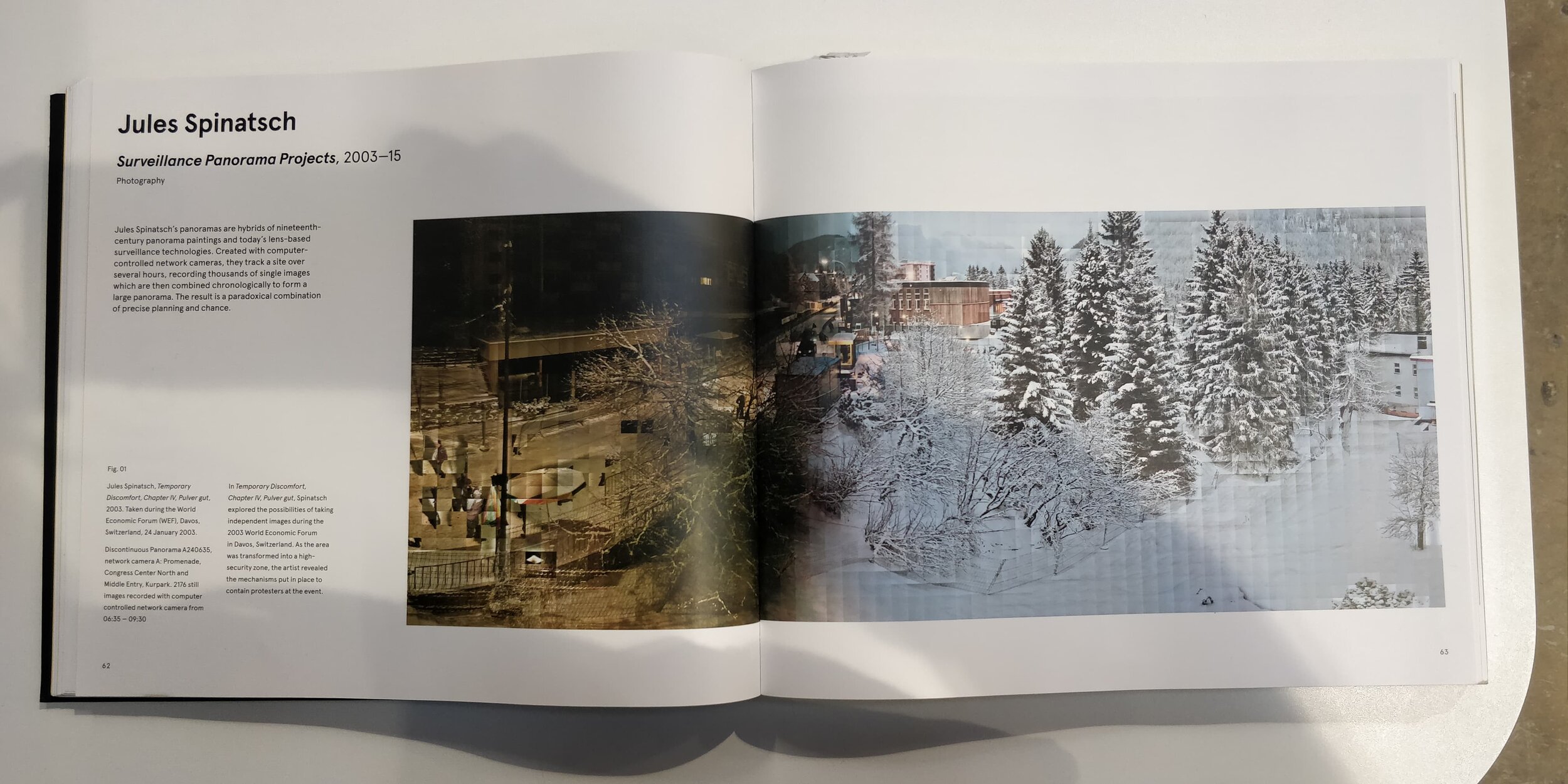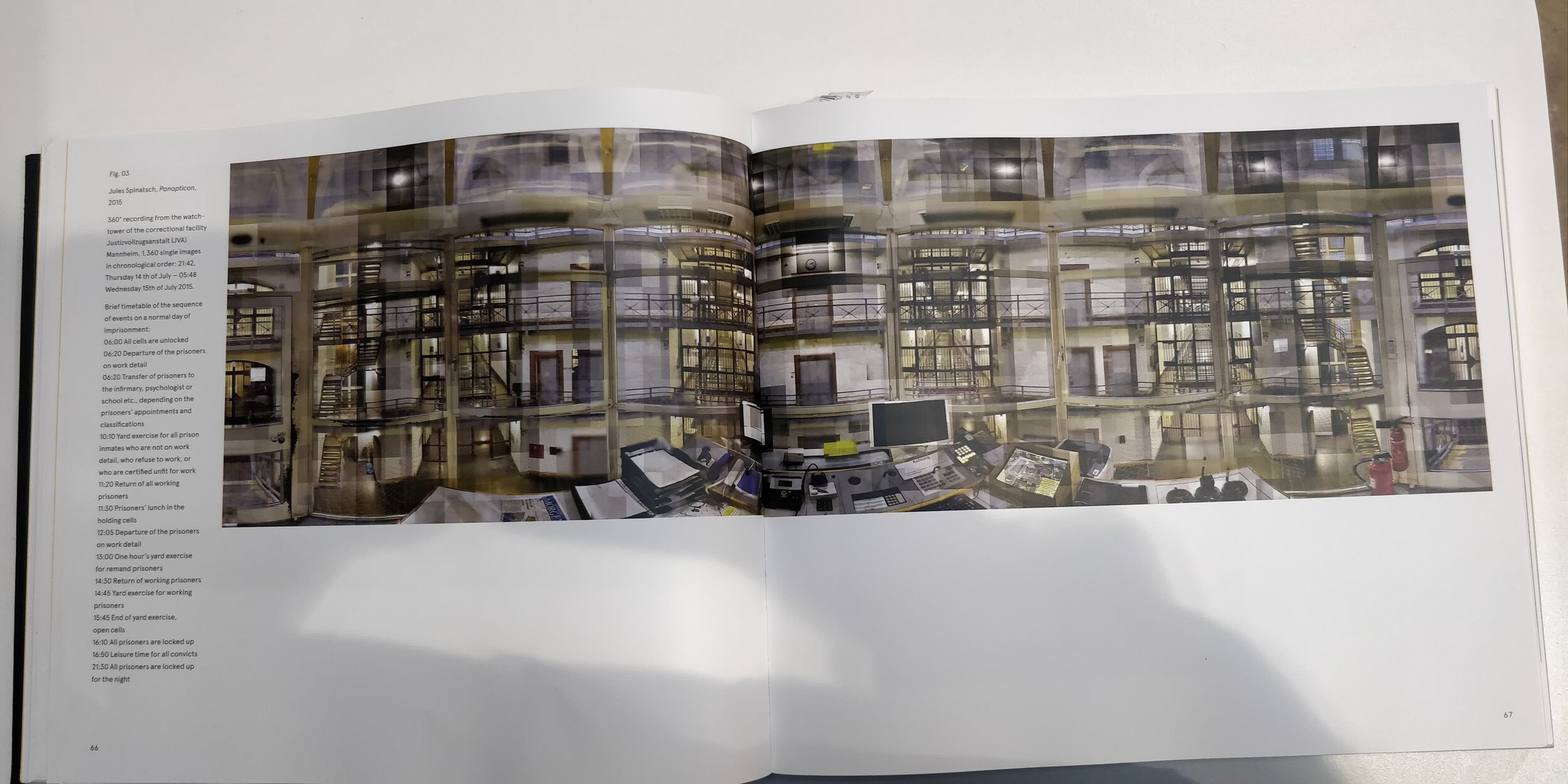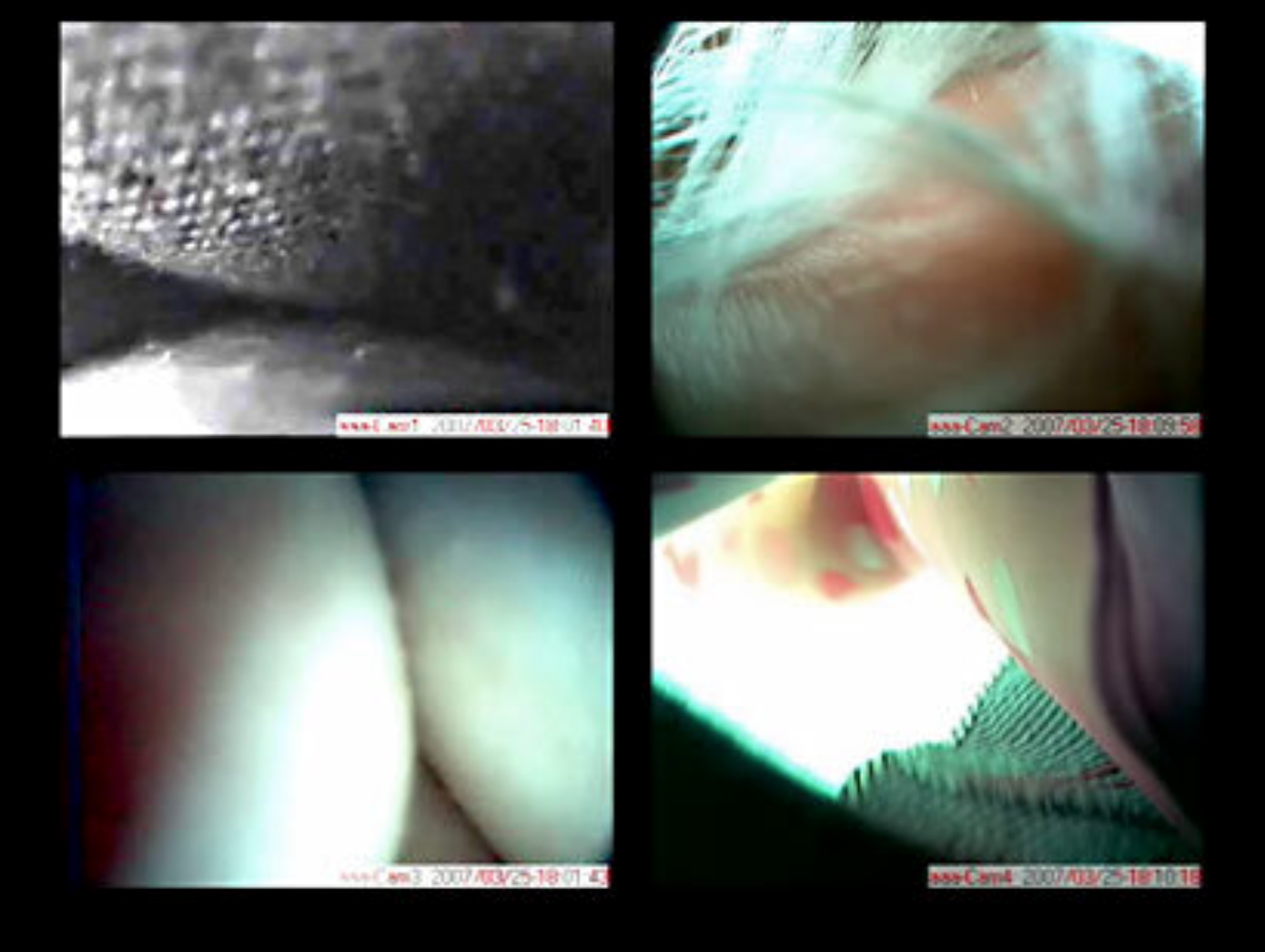I went onto the Library online and typed in ‘Surveillance’ and I couldn’t have received a better outcome than this book! I have found an infinite amount of inspiration through this book alone with a number of photographers and theoretical essays which I will be analysing through this blog post.
Watched! Surveillance, Art and Photography by Verlag der Buchhandlung and Walter König.
‘The 175th anniversary of photography was recently celebrated in a world in which cameras, photographs and the act of photographing and distributing images now dominate everyday life and spaces, and where, moreover, we live in a full-blown surveillance society in which the medium of photography plays an inextricable role.’ (Wolthers, L., Watched, pp.8)
In this day and age, it seems we are being watched from all angles of our lives, through social media, CCTV, photography and many other methods. But there are just some times when it seems very unethical to be watching someone, when they are getting dressed, going to the toilet, washing, or just in their private spaces. Of course, photographing or ‘spying’ on someone when they are considered to be in a private environment is a crime, but how easy is it really to do this without being found out?
The majority of us use social media every day, we post pictures of ourselves, we tag people, we share our location, it is very easy to locate someone and to know what they are doing and where they are, based on their social profiles or even using different applications through their phones, there are some people who are able to hack into computers and webcams, and so a lot of people feel the need to cover their webcams when they are not using them.
‘Today the concept of surveillance is applied to a wide range of practices, techniques and discourses. Watched! focuses on surveillance as a visual phenomenon, not necessarily in the concrete, literal sense of the act of viewing optimized by optical devices, but as a socio-political 'overview', or what the visual culture theorist Nicholas Mirzoeff calls a complex of visuality. Rather than being solely perceptual, Mirzoeff sees visualization as an imaginary practice. As he writes: 'Despite its name, this process is not composed simply of visual perceptions in the physical sense, but is formed by a set of relations combining information, imagination, and insight into a rendition of physical and psychic space'. (Wolthers, L., Watched, pp.9)
‘Modern life takes place on screen. Life in industrialized countries is increasingly lived under constant video surveillance from cameras in buses and shopping malls, on highways and bridges, and next to ATM cash machines. More and more people look back, using devices ranging from traditional cameras to camcorders and Webcams. These forms of visualization are now being challenged by interactive visual media like the Internet and virtual reality applications.
Let’s take a few examples from the constant swirl of the global village. The abduction of the toddler Jamie Bulger from a Liverpool shopping mall was impersonally captured by a video surveillance camera, providing chilling evidence of the ease with which the crime was both committed and detected. At the same time, despite the theory that constant surveillance provides increased security, it in fact did nothing to help prevent the child’s abduction and eventual murder.’ (Mirzoeff, N.,https://americansuburbx.com/2008/11/theory-nicholas-mirzoeff-introlduction.html, 2008)
This is such an interesting theory, we are being watched however what does this change really? I suppose in the extremely sad instance of Jamie Bulger, it was such a random act by the abductors that no one could have known what they were going to do, even though it may have been caught on camera, it did not change what was going on in their heads. This sense of being under constant surveillance seems to not always be a bad thing, I suppose it completely depends who you are being watched by.
On June 22nd 2020, the Sky News published an article revealing that from the 2017 Westminster attack until around that date, 25 terrorist acts had been prevented and counter-terrorism police were currently undergoing 800 live investigations, so I suppose in this instance, it feels good to know we are in a society where we are able to watch what others are doing and put this knowledge to good use by saving lives. (https://news.sky.com/story/25-terror-plots-have-been-foiled-since-2017-westminster-attack-minister-reveals-12012317)
It’s when people use this power of voyeurism over someone, for example when I was a child, I would so scared to do anything, just in case my stepfather or mother found out about it, I had this constant thought that they were watching me, no through cameras or phones, but just in my head, but that feeling was enough to scare me into not doing anything that would annoy them, although I was never too sure what would be bad or good in his mind.
Viktoria Binschtok - World of Details
In World of Details, Viktoria Binschtok uses Google Street View shots as the starting point for her work. These authorless, automated images showing a specific location in New York City are contrasted with her own high-resolution colour photos. Travelling to the same places, the artist attempts to plunge into the surface of the locations depicted by overcoming distance and getting physically closer to the objects. The result is two perceptions of the same place, reflecting today's use and perception of photography in the internet age. (Watched, pp.44)
I found this project to be quite funny, not because of the content but because whenever my boyfriend and I say we would like to go abroad somewhere, his dad says (in his strong Worcester accent) ‘Why don’t you just G’l’earth it to save money!?’ Meaning we should just Google Earth these places instead of spending our money on going to see them for ourselves! Funnily, I find this project almost counteracts his point, as it’s clear to me here that the Street view pictures are nothing compared to the beauty to the high-quality images!
The main reason I was so interested in this body of work, (other than my boyfriend’s dad being silly) is the contrast between the images; I really love how they work together, the low-quality street view images compared to the high-quality images that Binschtok has taken of the place. I also love how you can see these are the same places. I think it gives it a really nice feeling. I always love to go and see things that I have seen online or in pictures, and when you see it in real life, it makes it so much more pleasurable.
In my body of work, I will have a similar outcome using both high quality and low-quality images, so this photographer has really helped me to visualise how my final display will look.
Jules Spinatsch - Surveillance Panorama Projects 2003-2015
Jules Spinatsch's panoramas are hybrids of nineteenth-century panorama paintings and today's lens-based surveillance technologies. Created with computer-controlled network cameras, they track a site over several hours, recording thousands of single images which are then combined chronologically to form a large panorama. The result is a paradoxical combination of precise planning and chance.
I found Jules Spinatsch’ work to be extremely interesting, I really like how he used computer controlled cameras and creates a large image using loads of small images. This just goes to show, how much some cameras can actually see in one shot, they can zoom in so far and still have a good enough picture quality to distinguish people’s faces. This is great for crime, when security need to identify someone, however when it comes to an individual spying on someone, it can get quite creepy.
The prison images are fascinating as personally, I have never seen the inside of a prison, and I don’t think many others have either, so to be able to see it in this light, where it is visible that they have CCTV within the building to show that these people have to watch all of the time is really intriguing.
Mare Tralla - Protected 2007-2011
Mare Tralla's series of performance-based works address issues of security and protection from a feminist and post-Soviet perspective. The artist emphasizes the hypervisibility of subjects in general, and women in particular, by appropriating surveillant gazes, practices and technologies. The security camera as a manifestation of the all-seeing eye in the sky is brought down to earth, materialized and disarmed. (Watched, pp. 86)
When I first read Orwell's 1984 as a teenager living in Soviet Estonia, I compared his Big Brother to the Soviet regime and the constant surveillance of its citizens, or rather the fear of surveillance that the KGB had generated. In the meantime, contempo- rary capitalist societies have managed to move much have provided the tools and created a paranoia leading to closer to an Orwellian reality. Technological advances a permanent need to protect citizens and their property. controlled surveillance. Most surveillance is sold to citizens This has introduced us to a life under Big Brother's constant with the promise that it is for their own security and benefit. According to statistics, the United Kingdom has the most extensive CCTV camera network in urban Europe. When first arrived in London in 1996, I was surprised by how many signs I saw warning me of CCTV, and indeed where they were located. It was not uncommon to find one next to the toilet door in a pub. The question arose: how much private space do we have and which private space is actually under observation? Do they really need to have cameras in the toilets? Since then, the number of CCTV cameras in London has certainly multiplied. CCTV cameras are no longer omnipresent in the public domain only in the UK, most developed urban areas in the world are well equipped with surveillance technology. Furthermore, it is cheap and easy to buy such equipment and everybody can put up a surveil- lance system to protect their own property if they wish. It is impossible to live in a contemporary urban setting without being observed. We do not pay much attention to where cameras are and what they are recording, and we usually do not question what is done with the recorded material. We believe there are laws and regulations protecting us. Protected consists of several works which are interlinked, commenting on the obsession with protection. The works were produced over four years and may continue to evolve- The first project was produced for a solo exhibition in the Medienkunstlabor, Kunsthaus Graz in April 2007. (Tralla, M. 2011)
I found Mare Tralla’s work to be exceptionally compelling! She has proven to me how easy it is to relate to Orwell’s 1984 when you have been in a similar situation, in my case growing up with my stepdad being present, but also how important it is to realise that CCTV in today’s society is used from every angle.
Her work is extremely admirable, and her ways of provoking conversations about her work are fascinating! Wearing a t-shirt of her own naked body with the text ‘This body is protected by both visible and invisible CCTV cameras’ is a courageous thing to do and a very interesting topic as, as far as we are aware, we cannot always know when we are being watched, so she has almost made sure she is being watched, this way she can be sure that she is and does not have to have that anxiety of the unknown. It is interesting that more people responded to her naked body image being too ‘provocative’ than they did the cameras she was wearing. I suppose this is where the feminism side of things come in, but that’s a whole other story!
I also found it intriguing how you are not allowed to photograph the CCTV cameras; however painting them is fine, which seems very odd to me.
Essay extracts from book
‘While Evans' photos were more accessible for a relatively select public, namely one interested in art, Salomon's photographs catered to a larger public's desire for a kind of substitute life through the vicarious visual participation in events that they could otherwise not access. His gaze became the gaze of millions of people craving sensation. And it is here that a shift takes place: Whereas Walker Evans strove to find unguarded moments, Salomon was on the prowl for the naked, which no longer indicated vulnerability or authenticity, but rather traitorous exposure.’ (Bertrand, AC., Watched, pp.260)
It seems that Salomon became slightly addicted to the power of capturing images through secret cameras, which it is very easy to become, but the images he would capture would as stated ‘catered to a larger public's desire for a kind of substitute life through the vicarious visual participation in events that they could otherwise not access.’ as obviously there are some places and something that not everyone can see and so being able to see them through his imagery is quite exciting. It seemed that Evans would, even though capturing images, be a lot more careful of where and when he would be doing so. Evan’s project ‘Subway Portraits’ seems to have quite a relaxed tone to it as even though these people have no idea that are being photographed, anyone can use the subway and so anyone would be able to see the scene he is capturing, I feel this gives a beauty to the images as he has captured everyday candid shots. Salomon however, would photograph in areas such as the Embassy of The Netherlands and the Members of the Special Committee on Tax buildings in Washington, these are both scenes which everyday society would not see, and so it has a very exciting feel to it as it’s almost like we shouldn’t be looking at this images. This reminds me of Jack Latham’s image ‘Viewing Platform, Monte Rio’ where he photographed 2 men standing in the secret location - Bohemian Grove.
At the moment in which something that we are not supposed to see – because it belongs in a private realm – has been made visible with the help of photography, the photographic gaze is lost and crosses a line, showing that gaze's lack of respect for the depicted person's right to privacy. The Japanese photographer Kohei Yoshiyuki examined precisely this moment in which the photographic gaze transgressed a boundary, as well as the close connection between the medium of photography and voyeurism, in his series The Park, created in the early 1970s. The artist photographed couples clandestinely having sex in the parks of Tokyo. However his shots which he took unnoticed using a Kodak infrared flash, not only reveal the couples but also - even more importantly - the numerous voyeurs who were watching the couples make love.(Bertrand, AC., Watched, pp.261)
I suppose the idea of sex is almost always going to cross someone’s mind when it comes to voyeurism, but the interesting this about Kohei' Yoshiyuki’s - The Park project is the question of ‘What he always in on the voyeurism of these couples?’ It’s interesting how he takes images of the people who are watching yet he is also technically watching. I find this interesting in the sense of there is basically evidence of the voyeurs here, but no evidence of him, apart from obviously him publishing the images and claiming them. Did the couples know they were being watched?
“My intention was to capture what happened in the parks, so I was not a real ‘voyeur’ like them,” (Yoshiyuki, K. 2007)
“But I think, in a way, the act of taking photographs itself is voyeuristic somehow. So I may be a voyeur, because I am a photographer.” (Yoshiyuki, K. 2007)
Interestingly, it is both illegal to have sex in parks in Japan as well as watching people have sex, so really Yoshiyuki has captured two crimes in one, even though this was not his intention. In an article by Alexxa Gotthardt - How Photographer Kohei Yoshiyuki’s “The Park” Became a Cult Phenomenon it states that ‘He became friendly with them, joining their ranks. But when he took pictures, his focus wasn’t the lovers who came to fool around, but the Peeping Toms themselves. Yoshiyuki was stalking the stalkers.’ (Gotthardt, A., 2019) I found that last sentence quite amusing, not entirely sure why.
I found this work to interesting, as it original although it feels unoriginal due to it involving the idea of people watching others have sex, but the fact that Kohei' Yoshiyuki’s managed to make it about him watching the watchers is what intrigued me the most.











